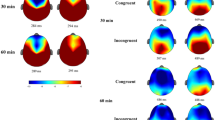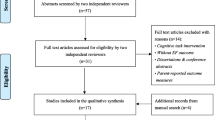Abstract
Previous studies have shown that aerobic exercise has beneficial effects on executive function in adolescents with attention-deficit hyperactivity disorder (ADHD). The underlying mechanisms could be partially due to aerobic exercise-induced cortical excitability modulation. The aim of this study was to explore the effects of acute aerobic exercise on executive functions and cortical excitability and the association between these phenomena in adolescents with ADHD. The study was conducted using a complete crossover design. Executive functions (inhibitory control, working memory, and planning) and cortical excitability were assessed in twenty-four drug-naïve adolescents with ADHD before and after acute aerobic exercise or a control intervention. Inhibitory control, working memory, and planning improved after acute aerobic exercise in adolescents with ADHD. Moreover, cortical excitability monitored by transcranial magnetic stimulation (TMS) decreased after intervention in this population. Additionally, improvements in inhibitory control and working memory performance were associated with enhanced cortical inhibition. The findings provide indirect preliminary evidence for the assumption that changes in cortical excitability induced by aerobic exercise partially contribute to improvements in executive function in adolescents with ADHD.




Similar content being viewed by others
Data availability
No datasets were generated or analysed during the current study.
References
Castellanos F et al (2006) Characterizing cognition in ADHD: beyond executive dysfunction. Trends Cogn Sci 10:117–123
Fayyad J et al (2017) The descriptive epidemiology of DSM-IV adult ADHD in the World Health Organization World Mental Health Surveys. ADHD Atten Deficit Hyperactivity Disorders 9(1):47–65
Biedermana J et al (2010) How persistent is ADHD? A controlled 10-year follow-up study of boys with ADHD. Psychiatry Res 177:299–304
Bellato A et al (2020) Is autonomic nervous system function atypical in attention deficit hyperactivity disorder (ADHD)? A systematic review of the evidence. Neurosci Biobehavioral Reviews 108:182–206
Arnsten AFT, Pliszka SR (2011) Catecholamine influences on prefrontal cortical function: relevance to treatment of attention deficit/hyperactivity disorder and related disorders. Pharmacol Biochem Behav 99(2):211–216
Castellanos FX, Proal E (2012) Large-scale brain systems in ADHD: beyond the prefrontal–striatal model. Trends Cogn Sci 16(1):17–26
Moll G et al (2000) Deficient intracortical inhibition in drug-naive children with attention-deficit hyperactivity disorder is enhanced by methylphenidate. Neurosci Lett 284(1):121–125
Gilbert DL et al (2019) Motor cortex inhibition and modulation in children with ADHD. Neurology 93(6):e599–e610
Gilbert DL et al (2011) Motor cortex inhibition: a marker of ADHD behavior and motor development in children. Neurology 76(7):615–621
Stahl SM (2010) Mechanism of action of alpha 2A-adrenergic agonists in attention-deficit/hyperactivity disorder with or without oppositional symptoms. J Clin Psychiatry 71(3):223–224
Sibley M et al (2014) Pharmacological and psychosocial treatments for adolescents with ADHD: an updated systematic review of the literature. Clin Psychol Rev 34:218–232
Shier AC et al (2013) Pharmacological treatment of attention deficit hyperactivity disorder in children and adolescents: clinical strategies. J Cent Nerv Syst Dis 5:1–17
Chueh T-Y et al (2022) Effects of a single bout of moderate-to-vigorous physical activity on executive functions in children with attention-deficit/hyperactivity disorder: a systematic review and meta-analysis. Psychol Sport Exerc 58:102097
Tsai Y et al (2021) Dose-response effects of acute aerobic exercise intensity on inhibitory control in children with attention deficit/hyperactivity disorder. Front Hum Neurosci 15:617596
Yu C-L et al (2020) The effects of acute aerobic exercise on inhibitory control and resting state heart rate variability in children with ADHD. Sci Rep 10(1):19958
Aston-Jones G (2005) J.D. Cohen AN INTEGRATIVE THEORY OF LOCUS COERULEUS-NOREPINEPHRINE FUNCTION: adaptive gain and optimal performance. Annu Rev Neurosci 28 28, 2005 p403–450
Pontifex MB et al (2019) A primer on investigating the after effects of acute bouts of physical activity on cognition. Psychol Sport Exerc 40:1–22
Poe GR et al (2020) Locus coeruleus: a new look at the blue spot. Nat Rev Neurosci 21(11):644–659
Nicolini C et al (2021) Understanding the neurophysiological and molecular mechanisms of exercise-induced neuroplasticity in cortical and descending motor pathways: where do we stand? Neuroscience 457:259–282
Real C et al (2010) Exercise-induced plasticity of AMPA-type glutamate receptor subunits in the rat brain. Brain Res 1363:63–71
McDonnell M et al (2013) A single bout of aerobic exercise promotes motor cortical neuroplasticty. J Appl Physiol 114:1174–1182
Morris TP et al (2020) Light aerobic exercise modulates executive function and cortical excitability. Eur J Neurosci 51(7):1723–1734
Singh AM et al (2014) Aerobic exercise modulates intracortical inhibition and facilitation in a nonexercised upper limb muscle. BMC Sports Sci Med Rehabilitation 6:23
Moll G, Heinrich H, Rothenberger A (2003) Methylphenidate and intracortical excitability: opposite effects in healthy subjects and attention-deficit hyperactivity disorder. Acta Psychiatr Scand 107(1):69–72
Gilbert DL et al (2006) Comparison of the inhibitory and excitatory effects of ADHD medications methylphenidate and atomoxetine on motor cortex. Neuropsychopharmacology 31(2):442–449
Chang YK et al (2012) Effect of acute exercise on executive function in children with attention deficit hyperactivity disorder. Arch Clin Neuropsychol 27(2):225–237
Chuang L-Y et al (2015) Effects of acute aerobic exercise on response preparation in a Go/No Go Task in children with ADHD: an ERP study. J Sport Health Sci 4(1):82–88
Benzing V, Chang Y-K, Schmidt M (2018) Acute Physical Activity enhances executive functions in children with ADHD. Sci Rep 8(1):12382
Suarez-Manzano S et al (2018) Acute and chronic effect of physical activity on cognition and behaviour in young people with ADHD: a systematic review of intervention studies. Res Dev Disabil 77:12–23
Borg G (1982) Psychophysical bases of perceived exertion. Med Sci Sports Exerc 14:377–381
Ludyga S et al (2020) The Acute effects of Aerobic Exercise on Cognitive Flexibility and Task-Related Heart Rate Variability in Children with ADHD and healthy controls. J Atten Disord 24(5):693–703
Piepmeier AT et al (2015) The effect of acute exercise on cognitive performance in children with and without ADHD. J Sport Health Sci 4(1):97–104
Logan GD, Cowan WB, Davis KA (1984) On the ability to inhibit simple and choice reaction time responses: a model and a method. J Exp Psychol Hum Percept Perform 10(2):276
Smith P et al (2013) A comparison of the Cambridge Automated Neuropsychological Test Battery (CANTAB) with traditional neuropsychological testing instruments. J Clin Exp Neuropsychol 35(3):319–328
Gau SS, Shang CY (2010) Executive functions as endophenotypes in ADHD: evidence from the Cambridge Neuropsychological Test Battery (CANTAB). J Child Psychol Psychiatry 51(7):838–849
Gau SS et al (2009) Executive function in adolescence among children with attention-deficit/hyperactivity disorder in Taiwan. J Dev Behav Pediatr 30(6):525–534
Kuo H et al (2023) A single bout of aerobic exercise modulates motor learning performance and cortical excitability in humans. Int J Clin Health Psychol 23(1):100333
Grundey J et al (2013) Cortical excitability in smoking and not smoking individuals with and without nicotine. Psychopharmacology 229(4):653–664
Ziemann U et al (1996) Effects of antiepileptic drugs on motor cortex excitability in humans: a transcrnial magnetic stimulation study. Ann Neurol 40:367–378
Kujirai T et al (1993) Cortical inhibition in human motor cortex. J Physiol 471:501–519
Ilić TV et al (2002) Short-interval paired-pulse inhibition and facilitation of human motor cortex: the dimension of stimulus intensity. J Physiol 545(1):153–167
Ziemann U et al (1998) Dextromethorphan decreases the excitability of the human motor cortex. Neuroplogy 51:1320–1324
Butzbach M et al (2019) Basic processes as foundations of cognitive impairment in adult ADHD. J Neural Transm 126(10):1347–1362
Smith A et al (2014) The influence of a single bout of aerobic exercise on short-interval intracortical excitability. Exp Brain Res 232:1875–1882
Yamazaki Y et al (2019) Acute low-intensity aerobic exercise modulates intracortical inhibitory and excitatory circuits in an exercised and a non-exercised muscle in the primary motor cortex. Front Physiol 7:1361
Richter MM et al (2007) Cortical excitability in adult patients with attention-deficit/hyperactivity disorder (ADHD). Neurosci Lett 419(2):137–141
Hendy AM et al (2022) Acute effects of High-Intensity Aerobic Exercise on Motor cortical excitability and inhibition in sedentary adults. Front Psychol 13:814633
Dutra TG, Baltar A, Monte-Silva KK (2016) Motor cortex excitability in attention-deficit hyperactivity disorder (ADHD): a systematic review and meta-analysis. Res Dev Disabil 56:1–9
Heijnen S et al (2015) Neuromodulation of Aerobic Exercise-A Review. Front Psychol 6:1890
Nitsche MA et al (2005) Modulating parameters of excitability during and after transcranial direct current stimulation of the human motor cortex. J Physiol 568(Pt 1):291–303
Meeusen R, De Meirleir K (1995) Exercise and brain neurotransmission. Sports Med 20(3):160–188
Hoerbelt P, Lindsley TA, Fleck MW (2015) Dopamine directly modulates GABAA receptors. J Neurosci 35(8):3525–3536
Di Mauro M et al (2008) Noradrenaline modulates neuronal responses to GABA in vestibular nuclei. Neuroscience 153(4):1320–1331
Lin TW, Kuo YM (2013) Exercise benefits brain function: the monoamine connection. Brain Sci 3(1):39–53
Gorrell S, Shott ME, Frank GKW (2022) Associations between aerobic exercise and dopamine-related reward-processing: informing a model of human exercise engagement. Biol Psychol 171:108350
Acknowledgements
The study is supported by the National Science and Technology Council, Taiwan, grant “112-2314-B-002-119-MY3”.
Author information
Authors and Affiliations
Contributions
H.I.K., M.N. and J.C.C. designed the work. H.I.K., J.C.C., and J.L.S. conducted the work. H.I.K., and J.L.S. prepared the manuscript. All authors reviewed the manuscript.
Corresponding author
Ethics declarations
Conflict of interest
The authors declare that there are no competing financial interests.
Rights and permissions
Springer Nature or its licensor (e.g. a society or other partner) holds exclusive rights to this article under a publishing agreement with the author(s) or other rightsholder(s); author self-archiving of the accepted manuscript version of this article is solely governed by the terms of such publishing agreement and applicable law.
About this article
Cite this article
Kuo, HI., Sun, JL., Nitsche, M. et al. An investigation of the acute effects of aerobic exercise on executive function and cortical excitability in adolescents with attention deficit hyperactivity disorder (ADHD). Eur Child Adolesc Psychiatry (2024). https://doi.org/10.1007/s00787-024-02467-x
Received:
Accepted:
Published:
DOI: https://doi.org/10.1007/s00787-024-02467-x




